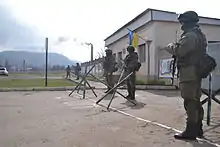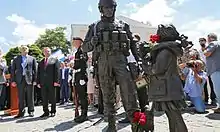Little green men (Ukrainian crisis)
The phrase "little green men" (Russian: зелёные человечки, romanized: zelyonye chelovechki; Ukrainian: зелені чоловічки, romanized: zeleni cholovichky) refers to masked soldiers of the Russian Federation[1] in unmarked green army uniforms and carrying modern Russian military weapons and equipment who appeared during the Ukrainian crisis of 2014.



The term first arose during the annexation of Crimea by the Russian Federation, a period from late February to March 2014, when such forces occupied and blockaded the Simferopol International Airport, most military bases in Crimea,[2] and the parliament in Simferopol. They also became known as "polite people" (Russian: вежливые люди, romanized: vezhlivye lyudi) as they were often perceived by local population to behave in a highly professional manner, despite being at the time a self-described "self-defense" force.[2][3][4]
The Russian Federation initially denied that these were Russian military forces, but on 17 April 2014 Russian President Vladimir Putin finally confirmed the presence of the Russian military.[5][6] Furthermore, numerous sources, including Russian state media, have confirmed that the "little green men" were a mix of operatives from the Special Operations Forces and various other Spetsnaz GRU units. Also, it was very likely the paratroopers of the 45th Guards Spetsnaz Brigade of the VDV made up a portion of it as well.[7][8][9]
Weapons and equipment analysis
In March 2014, the Finnish magazine Suomen Sotilas (Soldier of Finland) published an analysis of the weapons and equipment seen on photos of "little green men".
The article points to a number of weapons and pieces of equipment that it asserts are issued only to armed forces in the Russian Federation:
- New EMR camouflage combat uniforms
- New 6Sh112 or 6Sh117 tactical vest
- New 6B27, 6B7-1M composite helmet
- New 7.62 mm PKP machine guns
- 6B26 composite helmets (used only by airborne troops of the Russian Federation)
- 6Sh92-5 tactical vest (used only by airborne troops of the Russian Federation)
- Gorka-3 combat uniform (used only by Russian special forces and mountain troops)
- Smersh AK/VOG tactical vest (used only by Russian special forces)
The article goes on to conclude that with a very high probability "these troops are the 45th Guards Separate Reconnaissance Regiment of the VDV" based in Kubinka, Moscow.[9]
Other media has published a photo of an unmarked Russian soldier armed with a VSS Vintorez taken as proof of deployment of Russian special forces.[10]
Official Russian reaction
Initially, President of Russia Vladimir Putin stated that the men in green were not part of the Russian Armed Forces, but groups of local militia who had seized their weapons from the Ukrainian Army.[11] The SACEUR of NATO Allied Command Operations General Philip Breedlove said that these "green men" were in fact Russian troops.[12]
In March 2014, Putin continued to maintain that there was no pre-planned intervention,[13][14] but that "the heavily armed, tightly coordinated groups who took over Crimea's airports and ports at the start of the incursion – they were merely spontaneous 'self-defence groups' who may have acquired their Russian-looking uniforms from local [military] shops (voyentorg)".[15][16] According to the Ukrainian Association of Gun Owners, Ukrainian law does not allow the selling or carrying of firearms other than for hunting.[17]
On 17 April 2014, President Putin admitted publicly for the first time that Russian special forces were involved in the events of Crimea, for the purposes of protecting local people and creating conditions for a referendum.[5][6][18][19] Later, he admitted that the Russian Armed Forces had blocked the Armed Forces of Ukraine in Crimea during the events.[20]
In response to the question of the presence of Russian troops in Crimea, Russian Minister of Defence Sergey Shoygu said, "Regarding the statements about use of Russian special forces in Ukrainian events, I can only say one thing – it's hard to search for a black cat in a dark room, especially if it's not there," and added cryptically that searching for the cat would be "stupid" if the cat is "intelligent, brave, and polite".[21][22]
In April 2015, retired Russian Admiral Igor Kasatonov said that the "little green men" were members of Russian Spetsnaz special forces units. According to his information, Russian troop deployment in Crimea included six helicopter landings and three landings of Ilyushin Il-76 with 500 troops.[23][24][25][26]
In popular culture

- On 6 May 2015, a monument to "polite people" was erected in the city of Belogorsk, Amur Oblast, on the central square. It is made by the sculptor Konstantin Gilev in the form of a full-size figure of a Russian military man with a kitten in his arms. Russian Defense Minister Sergey Shoygu also supported the idea of installing a similar monument in Moscow.[27][28]
- Since February 2016, in the self-proclaimed Luhansk People's Republic, a children's magazine named "Polite little men" was published.
- On 11 June 2016, a special monument dedicated as a tribute to the "polite people" was opened in the city of Simferopol. The ceremony was attended by Head of the Republic of Crimea Sergey Aksyonov, presidential envoy of the Crimean Federal District Oleg Belaventsev, a company of the guard of honor of the Black Sea Fleet, the Crimean militia, a unit of one of the military units, as well as hundreds of Crimeans and guests of the capital. The composition consisted of a soldier in full ammunition, a girl with flowers and a cat rubbing at his feet. The author of the sculpture is Salavat Shcherbakov, who is an Academic of the Russian Academy of Arts and an honoured People's Artist of Russia.[29][30]
References
- Schreck, Carl (26 February 2019). "From 'Not Us' To 'Why Hide It?': How Russia Denied Its Crimea Invasion, Then Admitted It". rferl.org. Radio Free Europe/Radio Liberty. Archived from the original on 30 October 2019. Retrieved 30 October 2019.
- Shevchenko, Vitaly (11 March 2014). ""Little green men" or "Russian invaders"?". BBC News. Archived from the original on 29 December 2019. Retrieved 18 November 2015.
- Oliphant, Roland (2 March 2014). "Ukraine crisis: 'Polite people' leading the silent invasion of the Crimea". The Daily Telegraph. Archived from the original on 17 November 2015. Retrieved 18 November 2015.
In fact they have been so well behaved they even have their own joke Twitter feed − 'Vezhliviye Lyudi' − 'polite people.'
- Walker, Shaun (15 March 2016). "Syrian mission restores pride in Russian military after years of decay". The Guardian. Archived from the original on 1 November 2019. Retrieved 15 July 2019.
It all began with the annexation of Crimea in February 2014, when highly professional, well-equipped troops with no insignia fanned across the peninsula to surround Ukrainian army bases and key infrastructure points.
Dubbed 'polite people' for their calm demeanour and few words, there was little doubt the men were Russian soldiers, and after initial denials, the Russian authorities later revelled in the deception. Late last year, an image of a soldier and the words 'polite people' were even shone on to the outside of the Russian defence ministry building with a powerful laser beam for several weeks. - Путин: в Крыму действовали российские военные [Putin: there were Russian military operating in Crimea]. rferl.org (in Russian). Radio Free Europe/Radio Liberty. 17 April 2014. Archived from the original on 19 November 2015. Retrieved 19 November 2015.
- Lally, Kathy (17 April 2014). "Putin's remarks raise fears of future moves against Ukraine". The Washington Post. Archived from the original on 20 November 2015. Retrieved 19 November 2015.
- Synovitz, Ron (4 March 2014). "Russian Forces in Crimea: Who Are They And Where Did They Come From?". rferl.org. Radio Free Europe/Radio Liberty. Archived from the original on 16 February 2020. Retrieved 16 February 2020.
- Reeves, Shane R.; Wallace, David (2015). "The Combatant Status of the "Little Green Men" and Other Participants in the Ukraine Conflict". International Law Studies. 91: 393. Retrieved 16 February 2020.
- Pulkki, Arto (3 March 2014). "Krimillä on Venäjän asevoimien ensilinjan joukkoja" [Crimea has first-line troops of the Russian armed forces]. Suomen Sotilas (in Finnish). Retrieved 16 February 2020.
- Vaux, Pierre (18 May 2015). "Ukraine Presents Russian Sniper Rifle Taken From Captured Soldiers, Will Charge Them With 'Terrorism'". The Interpreter. Archived from the original on 20 April 2017. Retrieved 19 April 2017 – via Pressimus.
- "Путін: В Криму діють не війська РФ, а "загони самооборони", які забрали зброю в українців" (in Ukrainian). Espreso TV. 4 March 2014. Archived from the original on 3 March 2016. Retrieved 31 March 2014.
- Головнокомандувач НАТО у Європі вважає, що всі воєнізовані формування у Криму є армією РФ [Supreme commander of NATO in Europe believes that all paramilitary forces in Crimea are from the army of the Russian Federation] (in Ukrainian). RBK Ukraine. 12 March 2014. Archived from the original on 19 October 2017. Retrieved 9 November 2017.
- Fernández, Rodrigo (4 March 2014). "Putin no descarta una intervención si el caos se apodera de Ucrania" [Putin does not rule out intervention if chaos takes hold of Ukraine]. El País (in Spanish). Archived from the original on 19 October 2017. Retrieved 9 November 2017.
- Kaufmann, Stefan (4 March 2014). "Kommentar: Der Unberechenbare" [Commentary: The Unpredictable]. Handelsblatt (in German). Archived from the original on 19 October 2017. Retrieved 9 November 2017.
- Borger, Julian (4 March 2014). "Putin offers Ukraine olive branches delivered by Russian tanks". The Guardian. Archived from the original on 3 October 2017. Retrieved 9 November 2017.
- Avril, Pierre (4 March 2014). "Ukraine : Poutine souffle le chaud et le froid" [Ukraine: Putin blows hot and cold]. Le Figaro (in French). Archived from the original on 19 October 2017. Retrieved 9 November 2017.
- Kravchenko, Yevhehia (11 January 2012). Українська асоціація власників зброї: вільні люди носять зброю, раби - ні [Ukrainian Association of Gun Owners: free people carry weapons, slaves don't]. gurt.org.ua (in Ukrainian). GURT Resource Center. Archived from the original on 31 October 2017. Retrieved 9 November 2017.
- "Direct Line with Vladimir Putin". kremlin.ru. 17 April 2014. Archived from the original on 4 December 2017. Retrieved 19 November 2015.
- Gregory, Paul Roderick (5 May 2014). "Putin's 'Human Rights Council' Accidentally Posts Real Crimean Election Results". Forbes. Archived from the original on 28 June 2014. Retrieved 27 February 2016.
- Путин: Украинских военных в Крыму блокировали российские войска [Putin: Ukrainian militia in Crimea were blocked by Russian troops]. liga.net (in Russian). 17 November 2014. Archived from the original on 19 October 2017. Retrieved 9 November 2017.
- Skibina, Evgeniya (17 April 2014). Шойгу о 'зеленых человечках' на Украине: глупо искать черную вежливую кошку в темной комнате [Shoygu about the 'green men' in Ukraine: it's foolish to look for a black polite cat in a dark room]. Moskovskij Komsomolets (in Russian). Archived from the original on 25 April 2014. Retrieved 10 April 2015.
- "Kiev's claims over special forces 'resemble paranoia': Russia". Agence France-Presse. 17 May 2014. Archived from the original on 3 April 2015. Retrieved 21 March 2015 – via Zee News.
- Tambur, Silver, ed. (30 July 2015). "Finland shoring up Åland defenses against 'little green men'". Eesti Rahvusringhääling. Retrieved 28 November 2020.
- Urbanska, Tetyana (22 February 2018). "Operation "Crimea is Ours"". Ukrainian Independent Information Agency. Retrieved 28 November 2020.
- Owuor Otieno, Mark (8 February 2018). "Who Were the Little Green Men?". WorldAtlas. Retrieved 28 November 2020.
- "Российский адмирал объяснил, почему операцию "зеленых человечков" в Крыму прозевала разведка НАТО" [Russian admiral explained why NATO intelligence missed the "green men" operation in Crimea]. ТСН.ua (in Russian). 13 March 2015. Retrieved 28 November 2020.
- "Памятник "Вежливым людям" открыли в Амурской области". ria.ru. 6 May 2015.
- "Шойгу поддержал идею установки в Москве памятника "Вежливому человеку"". ria.ru. 6 May 2015.
- "В Симферополе открыли памятник "вежливым людям"". Interfax.ru. 11 June 2016.
- ""Вежливые люди" из бронзы появились в Симферополе". bbc.com/russian. 11 June 2016.
External links
| Wikimedia Commons has media related to Unmarked soldiers during the annexation of Crimea by the Russian Federation. |
- Ash, Lucy (29 January 2015). "How Russia outfoxes its enemies". BBC News Online. Retrieved 7 April 2015.